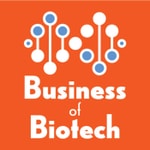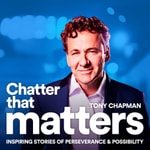Solve for X: Innovations to Change the World – Détails, épisodes et analyse
Détails du podcast
Informations techniques et générales issues du flux RSS du podcast.

Solve for X: Innovations to Change the World
MaRS Discovery District
Fréquence : 1 épisode/37j. Total Éps: 32

Classements récents
Dernières positions dans les classements Apple Podcasts et Spotify.
Apple Podcasts
🇨🇦 Canada - technology
28/07/2025#83🇺🇸 États-Unis - technology
28/07/2025#43🇨🇦 Canada - technology
27/07/2025#47🇺🇸 États-Unis - technology
27/07/2025#26🇨🇦 Canada - technology
26/07/2025#31🇺🇸 États-Unis - technology
26/07/2025#24🇨🇦 Canada - technology
25/07/2025#29🇺🇸 États-Unis - technology
25/07/2025#22🇨🇦 Canada - technology
24/07/2025#29🇺🇸 États-Unis - technology
24/07/2025#21
Spotify
Aucun classement récent disponible
Liens partagés entre épisodes et podcasts
Liens présents dans les descriptions d'épisodes et autres podcasts les utilisant également.
See allQualité et score du flux RSS
Évaluation technique de la qualité et de la structure du flux RSS.
See allScore global : 68%
Historique des publications
Répartition mensuelle des publications d'épisodes au fil des années.
Beast mode: Can technology help protect some of the world’s most endangered animals?
Saison 2 · Épisode 7
jeudi 4 janvier 2024 • Durée 25:16
We’re facing a global ecosystem crisis. Within the last 50 years alone, wildlife populations across the world have declined by a shocking 69 percent. But technology, with help from citizen science, is emerging as one of wildlife’s greatest allies. In this episode of Solve for X, we explore how remote sensing, robot boats and DNA analysis could revolutionize wildlife preservation, offering hope for everything from insects to whales.
Featured in this episode:
- James Snider is the vice president of science, knowledge and innovation at World Wildlife Fund Canada.
- Elizabeth Clare is an associate professor of biology at York University in Canada. Her research studies biodiversity at all levels, developing novel genetic methods that address some of the biggest challenges in biodiversity science.
- Peter Fretwell is a scientist at the British Antarctic Survey. He’s the principal investigator of the Wildlife From Space Program, studying wildlife using satellite imagery.
- Madeleine Bouvier-Brown is a marine project scientist at Open Ocean Robotics. She handles the deployment of robot boats, retrieving data and analyzing it to deepen our understanding of the oceans.
Further reading:
- Loss of sea ice causes catastrophic breeding failure for emperor penguins
- Adventure on high seas inspired ocean drone
- Global wildlife populations have declined by 69 percent since 1970, WWF report finds
- Scientists can suck animal DNA literally out of thin air
- Caribou are vanishing at an alarming rate. Is it too late to save them?
Solve for X is brought to you by MaRS, North America’s largest urban innovation hub and a registered charity. MaRS supports startups and accelerates the adoption of high-impact solutions to some of the world’s biggest challenges. For more information, visit marsdd.com.
Changing tastes: Can technology sustainably feed the world?
Saison 2 · Épisode 6
jeudi 14 décembre 2023 • Durée 22:12
Climate change is putting many of the foods we love at risk. Add in rapid population growth — the planet will be home to 9.7 billion people by 2050 — and it’s clear we need to reimagine how we feed ourselves. As food security expert Leonore Newman says, “we are running short on planet.” But is society ready for replacement proteins and lab-grown meats? Whether it’s cell-grown salmon or chili lime crickets, the plate of the future is going to look a little bit different. In this episode of Solve for X, we discuss the revolution in what we eat — and why it’s as much about technology as it is about safeguarding our planet’s future.
Featured in this episode:
- Lenore Newman, director of the Food and Agriculture Institute at the University of the Fraser Valley, is an expert in food security and technology and holds a UFV Research Chair in Food and Agriculture Innovation.
- Preeti Simran Sethi teaches sustainable food systems at the University of Gastronomic Sciences. She’s also the author of an award-winning book on agrobiodiversity, Bread, Wine, Chocolate: The Slow Loss of Foods We Love.
- Journalist and author Larissa Zimberoff explores the evolving relationship between food and technology in her work. Her book, Technically Food: Inside Silicon Valley’s Mission to Change What We Eat, delves into the transformations in our diets and the startups driving this shift.
- Darren Goldin is a co-founder of Entomo Farms, an insect-based farming company that produces cricket flour, cricket powder and insect protein. He’s also the vice president of farming operations, overseeing the three barns on Entomo’s property.
Further Reading:
- Protein shakeup: Are crickets and lab-grown meat the future of food?
- The foods humans ate into extinction
- How to grow fish from stem cells
- Our global food system is the primary driver of biodiversity loss
- The future of food: What will you be eating in 2050?
- Lab-Grown Meat Approved for Sale: What You Need to Know
Solve for X is brought to you by MaRS, North America’s largest urban innovation hub and a registered charity. MaRS supports startups and accelerates the adoption of high-impact solutions to some of the world’s biggest challenges. For more information, visit marsdd.com.
Confronting waste: Getting to a circular economy
Saison 1 · Épisode 7
jeudi 13 octobre 2022 • Durée 23:57
Humans generate an incredible amount of trash. In Canada alone, 35 million tonnes of food is wasted every year. That’s a lot of energy spent growing, processing, packaging and delivering food that ultimately goes uneaten — and all that waste creates a lot of greenhouse gases. To fix the climate, we have to redefine our relationship with waste; that means doing more with what we already produce. In this episode, we head up into space to see how astronauts deal with their waste, travel to a facility to learn how food scraps are being transformed into biogas and explore how the concept of circularity could help us manage our resources better. It’s time to face the waste.
Featured in this episode:
- Marc Garneau is a former astronaut and current Member of Parliament. During his space career, he logged nearly 700 hours in orbit, learning firsthand the value of maximizing resources and repurposing waste.
- Annie Meier, a chemical engineer and principal investigator at NASA, is the team lead on a trash-to-gas project called OSCAR (Orbital Syngas Commodity Augmentation Reactor), a technology that provides a new way of managing waste in space.
- Tammara Soma is an assistant professor at SFU and research director at The Food Systems Lab. As a food systems and waste expert, she researches the impact food waste has on the climate as well as solutions that could help bring greater circularity to the food system.
- Brandon Moffatt is the co-founder and vice president of StormFisher Hydrogen, a company focused on utilizing waste streams to create better uses for waste products. One of those areas: food-waste diversion. He walks us through the process of transforming organic waste to sources of energy.
- Chris Bataille is an independent consultant and applied policy researcher, working for Columbia University, Simon Fraser University and IDDRE in Paris. Focusing on industrial decarbonization and the low-carbon transition, Chris speaks to the role of biogas in climate strategy.
Further reading:
- Canada Throws Out Half the Food It Produces. What If We Ate It Instead?
- Food systems are responsible for a third of global anthropogenic GHG emissions
- Your Trash Is Emitting Methane In The Landfill. Here's Why It Matters For The Climate
- Expanded London biogas company now nation's largest food-waste diversion plant
- Team Prepares OSCAR Technology for Suborbital Flight Test | NASA
The Mission from MaRS initiative was created to help scale carbon reducing innovations by working to remove the barriers to adopting new technology. Mission from MaRS thanks its founding partners, HSBC, Trottier Family Foundation, RBC Tech for Nature and Thistledown Foundation. It has also received generous support from Peter Gilgan Foundation, BDC, EDC and Mitsubishi Corporation Americas. Learn more about the program at missionfrommars.ca.
Solve for X is brought to you by MaRS, North America’s largest urban innovation hub and a registered charity. MaRS supports startups and accelerates the adoption of high-impact solutions to some of the world’s biggest challenges. For more information, visit marsdd.com.
Can AI help build a more liveable city?
Saison 1 · Épisode 6
jeudi 29 septembre 2022 • Durée 24:49
As we start to feel the effects of climate change, it’s clear we need to find ways to adapt our communities and lighten the impact on the planet. It can be tempting to just start over somewhere fresh — to build a fully optimized city that’s decked out with the latest technology to be sustainable and efficient. But as we’ve seen in one smart city development after another, these projects often fail to live up to the hype. It might be time to rethink what a smart solution actually looks like. In this episode, we learn about two companies that are harnessing the power of artificial intelligence to retrofit what already exists. By optimizing heating and cooling systems and re-tooling public transit, these two ventures are already helping shrink the carbon footprint of cities. It’s a good reminder of the power of incremental change.
Featured in this episode:
- Sarah Moser is a professor of urban geography at McGill University. She heads up the New Cities Labs and researches these new developments — what they promise and what actually gets built. She speaks to the need of digital literacy to evaluate technology and make sure it serves the needs of the community.
- David Rolnick is an assistant professor and Canada CIFAR AI Chair in the School of Computer Science at McGill University and at Mila. He also is a co-founder and chair of Climate Change AI, and scientific co-director of Sustainability in the Digital Age. Specializing in machine learning and climate change, he talks us through how machine learning can be used to help us mitigate and adapt to the climate crisis.
- Sam Ramadori is the CEO of BrainBox AI. We learn about his smart platform, why reducing energy emissions of buildings are so important and why we need to scale this kind of technology.
- Remi Desa is the co-founder and CEO of Pantonium — a on-demand ride-share app designed for buses. Pantonium’s platform brings real-time insights to public transportation and helps address the challenges faced in fixed-route systems.
- Marty LeDuc is a bus driver in the city of Fort Erie, and currently drives one of the vehicles utilizing the Pantonium software. With more than 20 years of experience under his belt, he speaks to the differences on-demand transit has made, and how change can be difficult.
Further reading:
- Toronto wants to kill the smart city forever
- Nine million people in a city 170 km long; will the world ever be ready for a linear metropolis?
- The Reality of Abu Dhabi's Unfinished Utopia
- Mila announces a partnership with BrainBox AI to support the launch of the company's first meta-learning project
- Addressing climate change by retrofitting Canada’s existing buildings
- To make U.S mobility more sustainable, improve access to public transit
The Mission from MaRS initiative was created to help scale carbon reducing innovations by working to remove the barriers to adopting new technology. Mission from MaRS thanks its founding partners, HSBC, Trottier Family Foundation, RBC Tech for Nature and Thistledown Foundation. It has also received generous support from Peter Gilgan Foundation, BDC, EDC and Mitsubishi Corporation Americas. Learn more about the program at missionfrommars.ca.
Solve for X is brought to you by MaRS, North America’s largest urban innovation hub and a registered charity. MaRS supports startups and accelerates the adoption of high-impact solutions to some of the world’s biggest challenges. For more information, visit marsdd.com.
The grid: Is it time to rethink our power systems?
Saison 1 · Épisode 5
jeudi 15 septembre 2022 • Durée 27:43
Our energy grid is something most of us only think about when it isn’t working. But growing demand for electricity is placing an even greater strain on a system that’s already facing increased pressure from extreme weather events. Can we build a more sustainable and dependable grid? In this episode, we explore how when it comes to climate change, the challenge of greening the grid is as much an issue of complex engineering as it is about policy and equity.
Featured in this episode:
- Josh Wong is the CEO of Opus One Solutions, a company that is working to optimize the grid and make it easier for utilities to integrate renewable sources of energy with its data analysis software. Josh is working to address the energy trilemma (reliability, resiliency, decarbonization) by offering greater transparency on the supply and demand of electricity.
- Destenie Nock is an assistant professor at Carnegie Mellon University who specializes in public policy, civil and environmental engineering. She’s an expert on how our changing climate is impacting the grid, and what that means for the future. Focusing on energy equity, Destenie explains what’s important to consider in our transition to clean energy.
- Dana Tizya-Tramm is the chief of the Vuntut Gwitchin First Nation in Old Crow, Yukon. Dana helped establish the Old Crow Solar Project — shifting the northern remote community off diesel to renewables. Through his efforts, Old Crow is making inroads toward energy sovereignty.
Further reading:
- 2021 placed exceptional demands on electricity markets around the world
- Renewable Energy Is Great—but the Grid Can Slow It Down
- Global heat waves are so bad that utilities are paying their customers to use less energy
- “Nation-building” investments in electricity grid needed to reach net-zero, experts say
- How Old Crow's solar farm is changing green energy projects in Yukon | CBC News
The Mission from MaRS initiative was created to help scale carbon reducing innovations by working to remove the barriers to adopting new technology. Mission from MaRS thanks its founding partners, HSBC, Trottier Family Foundation, RBC Tech for Nature and Thistledown Foundation. It has also received generous support from Peter Gilgan Foundation, BDC, EDC and Mitsubishi Corporation Americas. Learn more about the program at missionfrommars.ca.
Solve for X is brought to you by MaRS, North America’s largest urban innovation hub and a registered charity. MaRS supports startups and accelerates the adoption of high-impact solutions to some of the world’s biggest challenges. For more information, visit marsdd.com.
Solve for X Mid-season Trailer
Saison 1
jeudi 1 septembre 2022 • Durée 01:26
This week we’re on pause, returning September 15th to our regular schedule. Exciting things are in the works: in coming episodes I’ll be talking to a scientist behind a robot lab and exploring how we can extract value from waste — even in space. But we also want to hear from you: what climate solutions are you interested in? Is there a certain technology that needs decoding? Send us a note at [email protected] — and don’t forget to turn on alerts for our upcoming episodes! Catch you soon.
The Mission from MaRS initiative was created to help scale carbon reducing innovations by working to remove the barriers to adopting new technology. Mission from MaRS thanks its founding partners, HSBC, Trottier Family Foundation, RBC Tech for Nature and Thistledown Foundation. It has also received generous support from Peter Gilgan Foundation, BDC, EDC and Mitsubishi Corporation Americas. Learn more about the program at missionfrommars.ca.
Solve for X is brought to you by MaRS, North America’s largest urban innovation hub and a registered charity. MaRS supports startups and accelerates the adoption of high-impact solutions to some of the world’s biggest challenges. For more information, visit marsdd.com.
How to speed up cleantech development
Saison 1
jeudi 18 août 2022 • Durée 14:22
To take new climate solutions from the lab out into the world can take hundreds of millions of dollars in investment. But as the pressure intensifies to hit our climate targets, the rapid commercialization of clean technologies is critical. On this special bonus episode, guest host Lara Torvi sits down with cleantech investor Susan Rohac to discuss the opportunities and challenges Canada faces to commercialize climate technologies at full scale.
Featured in this episode:
- As the vice president of the Cleantech Practice at BDC (the Business Development Bank of Canada), Susan Rohac sees the potential for global impact in climate tech. She leads her team in helping cleantech companies get the support and funding they need to scale successfully. With the responsibility of managing a $600-million fund, she’s one of the largest climate tech investors in the country.
Further Reading:
- Canadian food tech companies could lead the global food revolution
- Clean Slate: How Canada Can Spur Growth by Procuring From Its Own Cleantech Startups
- Genecis Raises US$10 Million in Funding to Commercialize Biodegradable Plastic Products
- Clean tech could be worth more than oil by 2030
The Mission from MaRS initiative was created to help scale carbon reducing innovations by working to remove the barriers to adopting new technology. Mission from MaRS thanks its founding partners, HSBC, Trottier Family Foundation, RBC Tech for Nature and Thistledown Foundation. It has also received generous support from Peter Gilgan Foundation, BDC, EDC and Mitsubishi Corporation Americas. Learn more about the program at missionfrommars.ca.
Solve for X is brought to you by MaRS, North America’s largest urban innovation hub and a registered charity. MaRS supports startups and accelerates the adoption of high-impact solutions to some of the world’s biggest challenges. For more information, visit marsdd.com.
Sparking change: Designing a cleaner energy future
Saison 1 · Épisode 4
jeudi 4 août 2022 • Durée 25:17
Humans are wired to want more. More time, more resources, more money. But what if we could do more with what we already have? When we innovate for resilience, we often think big — bypassing solutions in our own homes. Today, we’re looking at the design of objects (like electric cars and heat pumps) and discovering their purpose can go far beyond the original intent. As we move to more sustainable forms of power, energy storage is becoming increasingly important. Here, we explore novel ways we can address energy intermittency in the future and also look back in history for lessons in making those kinds of changes.
Featured in this episode:
- François Lefèvre is a senior manager of market intelligence and corporate planning at Nissan Canada. He’s watched the evolution of EVs in Canada — and is an expert on the many models of Nissan LEAF.
- Ruth Sandwell is an energy historian who teaches at OISE and the University of Toronto. She researches the changes in household behaviour that resulted from the adoption of new forms of energy systems.
- Imran Noorani is the CSO of Peak Power and a clean energy enthusiast. Peak Power’s AI-based technology optimizes buildings through the intelligent management of energy use, energy storage and EV-grid integration.
- Wayne Grosko is an applied research scientist who studies renewable energy. Wayne focuses on the piloting of new technologies, one of them being the Stash Energy heat pump.
- Daniel Larsen, co-founder & CPO of Stash Energy. Stash has created a heat pump that goes further than the traditional. Not only does it heat and cool homes, it actually stores heat energy and uses it during peak hours to offset demand on the grid (and consumer’s wallets).
Further Reading:
- Why You (and the Planet) Really Need a Heat Pump
- How storing energy without batteries could be key to N.S. giving up fossil fuels
- How electric vehicles could transform the power grid
- How Households Shape Energy Transitions
- Driving Change: Transportation And Electric Utility Industries Will Soon Collide – In A Good Way
The Mission from MaRS initiative was created to help scale carbon reducing innovations by working to remove the barriers to adopting new technology. Mission from MaRS thanks its founding partners, HSBC, Trottier Family Foundation, RBC Tech for Nature and Thistledown Foundation. It has also received generous support from Peter Gilgan Foundation, BDC, EDC and Mitsubishi Corporation Americas. Learn more about the program at missionfrommars.ca.
Solve for X is brought to you by MaRS, North America’s largest urban innovation hub and a registered charity. MaRS supports startups and accelerates the adoption of high-impact solutions to some of the world’s biggest challenges. For more information, visit marsdd.com.
Fighting greenwashing: A conversation with Catherine McKenna
Saison 1 · Épisode 3
jeudi 21 juillet 2022 • Durée 24:47
Net-zero commitments are a critical first step in the fight against climate change. But to stave off the worst effects of a warming planet, we actually have to ensure countries and corporations live up to those promises. In this episode, we chat with Catherine McKenna, head of the UN Task Force against greenwashing, about regulations and accountability when it comes to net-zero targets, as well as how incentives might help. We need to quickly scale climate solutions; which means tackling bureaucratic hurdles. Nothing is off limits.
Featured in this episode:
- Catherine McKenna, Canada’s former Minister of the Environment and Climate Change. Catherine’s current role (as founder and principal) focuses on scaling Climate and Nature Solutions. She’s also the Chair of the UN Secretary General’s new High-Level Expert Group on Net-Zero Commitments of Non-State Entities, and if that wasn’t enough — Catherine is an avid open water swimmer and mother of three. She shares her perspective on what it takes to make progress on the climate file.
Further Reading:
- Corporate net-zero pledges have a long way to go
- Just 100 companies responsible for 71% of global emissions
- Climate Emergency, Calling Intergovernmental Panel’s Report ‘a File of Shame’
- Catherine McKenna to chair UN panel on climate change progress
- Four key climate change indicators break records in 2021
The Mission from MaRS initiative was created to help scale carbon reducing innovations by working to remove the barriers to adopting new technology. Mission from MaRS thanks its founding partners, HSBC, Trottier Family Foundation, RBC Tech for Nature and Thistledown Foundation. It has also received generous support from Peter Gilgan Foundation, BDC, EDC and Mitsubishi Corporation Americas. Learn more about the program at missionfrommars.ca.
Solve for X is brought to you by MaRS, North America’s largest urban innovation hub and a registered charity. MaRS supports startups and accelerates the adoption of high-impact solutions to some of the world’s biggest challenges. For more information, visit marsdd.com.
We need to save the trees — but how?
Saison 1 · Épisode 2
jeudi 7 juillet 2022 • Durée 27:50
Trees have an incredible ability to absorb carbon — which means protecting, planting and restoring forests are a (relatively) easy way to address global warming. Climate change, however, is making it more complicated. Our forests are (quite literally) going up in smoke, which has far worse consequences than one might expect. In this episode, we explore the role forests play in carbon sequestration, how increasingly intense fires are threatening to turn them into a carbon bomb, and how technology (think drones, satellites and lasers) can assist in our replanting and conservation efforts. The forests have helped us, it’s time to help them.
Featured in this episode:
- Lola Fatoyinbo-Agueh is a NASA scientist. Working in the biospheric sciences lab, she studies forest ecology and ecosystem structure, using LiDAR to GEDI (more on that later) to map and measure the amount of carbon sequestered by trees.
- Faisal Moola, a biologist. He’s an associate professor at the University of Guelph, and an expert on forest conservation, biodiversity (conducting inventory of areas using drones) as well Indigenous partnerships. He helps us understand what we’ve done in the past to hurt forests, and how we can heal them.
- Amy Cardinal Christianson is a fire research scientist, who specializes in Indigenous fire stewardship and talks about the role of fire in the overall health of trees. She is also a host of a podcast called “Good Fire.”
- Stephen Elliott is the co-founder and research director of the Forest Restoration Research Unit of Chiang Mai University (FORRU-CMU) in Northern Thailand. He works with communities in replanting efforts and has a particular interest in automated forest restoration.
Further Reading:
- How to build forests to combat climate change
- Tree Planting Is Booming. Here’s How That Could Help, or Harm, the Planet
- One of Canada’s biggest carbon sinks is circling the drain
- Climate change could expand forests. But will they cool the planet? | Science
- Drone-based technology remotely assesses health of trees impacted by climate change
- Landsat’s Critical Role in Forest Management
The Mission from MaRS initiative was created to help scale carbon reducing innovations by working to remove the barriers to adopting new technology. Mission from MaRS thanks its founding partners, HSBC, Trottier Family Foundation, RBC Tech for Nature and Thistledown Foundation. It has also received generous support from Peter Gilgan Foundation, BDC, EDC and Mitsubishi Corporation Americas. Learn more about the program at missionfrommars.ca.
Solve for X is brought to you by MaRS, North America’s largest urban innovation hub and a registered charity. MaRS supports startups and accelerates the adoption of high-impact solutions to some of the world’s biggest challenges. For more information, visit marsdd.com.








